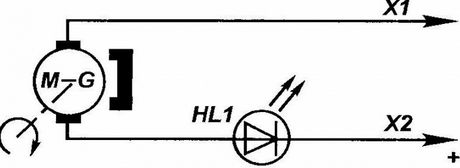
|
|
ENCYCLOPEDIA OF RADIO ELECTRONICS AND ELECTRICAL ENGINEERING Electric motor as a probe. Encyclopedia of radio electronics and electrical engineering
Encyclopedia of radio electronics and electrical engineering / Indicators, detectors, metal detectors Among the devices used to test (diagnostic) electrical circuits, probes are not the last. They are simple in design and use. A probe is an indicator, with which, as a rule, a galvanic cell (battery), a current-limiting resistance and two probes are connected in series. Touching the various parts of the circuit with the probes, check the serviceability of all its parts and the correctness of their connections. But in addition to galvanic cells, other power sources are also known. Why not use them in the design of the probe and make a device, for example, based on electromagnetic induction. I became convinced of the prospects of this idea by assembling a scheme that in many ways resembles a school demonstration experiment on the study of Faraday's laws. The source of electricity was a multi-turn coil (series-connected windings of a polarized relay RP-4) with a permanent "strip" magnet 3x3x40 inserted inside, the end of which is connected to a steel spring. As an indicator, an LED with a rated glow current of 20 mA was the best fit. The probes were two pieces of flexible installation wire in vinyl insulation, equipped with crocodile clips. Of course: if you press on the magnet core (or pull it out of the coil a little), and then release it, the spring will return the electromagnetic system to its original position. In the coils, an induction emf will appear, proportional to the rate of change of the magnetic flux. When connected to a probe with such a power source, for example, a working diode, the indicator light will light up only with one connection polarity of the junction. If there is a flash at both polarities, then the tested diode is "broken". When there are no flashes at any polarity, it means that there is an internal break in the semiconductor device under study.
In the same way, np junctions are checked for powerful transistors. Given that the collector of such semiconductor triodes is connected to the case, you can find out their pinout without having the appropriate reference book at hand. Having made sure that the design considered above was working, I began to experiment with other variants of a home-made probe, embedding "non-standard power supplies" such as a TK-67-NT telephone capsule or a 1GD-28 speaker instead of galvanic cells. And he made sure that when tapping on the diffuser in the voice coils of such electromagnetic systems, an EMF arises that is sufficient for the LED to check the health of electrical circuits. However, it is most convenient to perform dialing with a probe, in which a standard microelectric motor (for example, from electrified toys or a cassette recorder) is used as a power source, which now serves as a generator. In addition, such a device compares favorably with the rest in simplicity, reliability and originality of the design itself. Especially if the body is used ... "modernized" plastic bottle for shampoo or other household chemicals (see. Fig.). For a probe, only a neck from this container with a transparent central part is required, into which a series-connected LED and a power source-microelectric motor-generator are inserted, fixed with studs with nuts-terminals. Flexible leads are screwed to them, having crocodile clips for connecting to the tested section of the electrical circuit. If the circuit is working, then when the generator shaft is turned, flashes of the LED occur, which can be seen even with peripheral vision. In conclusion, a little advice to those who decide to make a probe with an LED indicator and a microelectric motor-generator instead of a galvanic power source. Even at the prototyping stage, you should make sure that the polarity of the LED is set correctly: the anode to the "positive" output of the mechanical energy converter (turning the rotor in the direction you are used to - for example, clockwise) into electrical energy. It is desirable to provide the shaft itself with a ribbed tip, which can be used as a screw cap from a tube of toothpaste. Author: S.Levchenko
Machine for thinning flowers in gardens
02.05.2024 Advanced Infrared Microscope
02.05.2024 Air trap for insects
01.05.2024
▪ Updated Specification for Lightning Connector ▪ Crystal is 1,6 times stronger and harder than diamond ▪ Hearing aid that reads lips even through a mask ▪ TB6865FG and TB6860WBG Wireless Charging Chips ▪ Washing machine from Porsche
▪ section of the site Intercoms. Article selection ▪ article The whole world is a theater. In it, women, men - all actors. Popular expression ▪ article Why Jews couldn't buy Tamagotchi? Detailed answer ▪ Hevea's article. Legends, cultivation, methods of application ▪ article Car amplifier 70 W. Encyclopedia of radio electronics and electrical engineering ▪ article Simple charger. Encyclopedia of radio electronics and electrical engineering
Home page | Library | Articles | Website map | Site Reviews www.diagram.com.ua |






 Arabic
Arabic Bengali
Bengali Chinese
Chinese English
English French
French German
German Hebrew
Hebrew Hindi
Hindi Italian
Italian Japanese
Japanese Korean
Korean Malay
Malay Polish
Polish Portuguese
Portuguese Spanish
Spanish Turkish
Turkish Ukrainian
Ukrainian Vietnamese
Vietnamese


 Leave your comment on this article:
Leave your comment on this article: